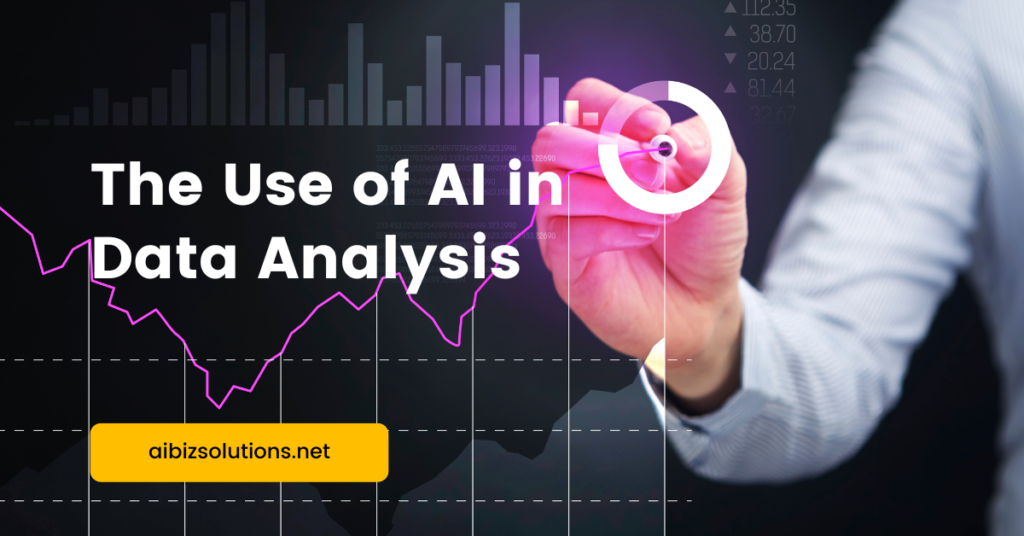
AI, or artificial intelligence, is a rapidly growing technology that has been making waves across many industries, including data analytics. In data analytics, AI is utilized to improve decision-making, predictive analysis, and data-driven insights.
AI refers to the ability of machines to perform tasks that usually require human intelligence, such as learning, reasoning, perception, and decision-making. By integrating AI into data analytics, organizations can gain deeper insights from large datasets, optimize business processes, and deliver better customer experiences.
So, what is AI used for in data analytics? AI can assist with data cleaning, data modeling, and data visualization. It can also help to identify patterns, anomalies, and trends in complex datasets. Machine learning algorithms, a subset of AI, allows systems to learn from data and improve their accuracy over time.
The integration of AI in data analytics has revolutionized the field, allowing organizations to analyze massive amounts of data in real-time, identify new opportunities, and make data-driven decisions with greater accuracy and speed.
Key Takeaways:
- AI is used in data analytics to enhance decision making and predictive analysis.
- AI helps with data cleaning, modeling, and visualization.
- Machine learning algorithms allow systems to learn from data and improve accuracy over time.
- The integration of AI in data analytics has revolutionized the field, allowing organizations to analyze large volumes of data in real-time.
- AI in data analytics enables organizations to make data-driven decisions with greater accuracy and speed.
The Importance of AI in Data Analytics
Artificial Intelligence (AI) is revolutionizing data analytics, providing organizations with the tools they need to mine vast amounts of data quickly and efficiently. The importance of AI in data analytics cannot be overstated, as it enables businesses to optimize data-driven decision making and drive growth through insights gained from complex data sets.
Applications of AI in Data Analytics
AI is being used in a variety of ways to enhance data analytics. One of the most significant applications of AI in data analytics is in machine learning, in which algorithms are trained on data sets to identify patterns and make predictions. By leveraging AI in data analytics, businesses can quickly analyze large amounts of data and gain rapid insights that can be used to optimize operations, improve customer experiences, and drive innovation.
AI is also being used in natural language processing (NLP), allowing businesses to unlock insights from unstructured data, such as customer reviews or social media posts. With NLP, businesses can analyze text data from a variety of sources and gain valuable insights into customer sentiment, preferences, and needs.
The Importance of AI-Driven Data Analytics
The importance of AI-driven data analytics lies in its ability to handle large volumes of data and identify patterns and insights that would be difficult, if not impossible, to uncover manually. By automating data analysis processes through AI, businesses can save time and resources, while simultaneously improving the accuracy and efficiency of data analysis.
AI-driven data analytics can also improve scalability, allowing businesses to analyze data in real-time and make decisions based on up-to-date information. This can help businesses to remain agile and competitive in rapidly changing markets.
Overall, the importance of AI in data analytics cannot be overstated. By leveraging AI, businesses can unlock valuable insights that can drive growth, optimize operations, and improve customer experiences. Whether through machine learning, NLP, or other AI-driven technologies, the benefits of AI in data analytics are clear and significant.
The Benefits of AI-Driven Data Analytics
Artificial Intelligence (AI) has transformed the field of data analytics, enabling businesses to gain valuable insights from complex data sets and make more informed decisions. The benefits of AI-driven data analytics are numerous and include:
- Efficiency: AI-powered data analytics can quickly process vast amounts of data, reducing the time it takes to generate insights and eliminating the need for manual data processing.
- Accuracy: By learning from past data, AI can make predictions with high accuracy, enabling businesses to make data-driven decisions with confidence.
- Scalability: AI-driven data analytics can handle large and growing data sets with ease, ensuring that businesses can continue to generate insights even as their data volumes increase.
- Cost-saving potential: By reducing the time and effort required for data processing and analysis, AI can help businesses save money and resources.
Furthermore, AI-driven data analytics can uncover valuable insights that would be difficult or impossible to find manually, enabling businesses to make more informed and strategic decisions. For example, AI can identify patterns and trends in customer behavior, enabling businesses to optimize their marketing and sales strategies to better meet customer needs.
According to a recent study by McKinsey & Company, companies that adopt AI-powered data analytics can improve their profit margins by up to 60 percent, highlighting the significant impact that AI can have on business growth.
In conclusion, AI-driven data analytics is a powerful tool for businesses looking to gain a competitive edge in today’s data-driven economy. By leveraging the benefits of AI, businesses can improve efficiency, accuracy, and scalability, while uncovering valuable insights that drive growth and innovation.
The Role of AI in Data Analysis
Artificial Intelligence (AI) plays a critical role in data analysis, enhancing the accuracy, speed, and scalability of data-driven decision making. By leveraging machine learning algorithms and natural language processing, AI can identify patterns, detect anomalies, and uncover valuable insights in large datasets that would be impossible for humans to process manually.
The integration of AI in data analytics workflows has revolutionized the way businesses operate, enabling them to make data-driven decisions quickly and efficiently, with minimal human intervention. Through AI and data analytics integration, organizations can achieve unprecedented levels of automation, reducing the time and resources required to analyze and interpret complex data.
One key advantage of AI in data analysis is its ability to handle unstructured data, such as text, images, and video, which are often difficult to analyze with traditional data analysis tools. By leveraging natural language processing, AI can extract insights from textual data, enabling businesses to analyze customer reviews, social media posts, and other unstructured data sources, gaining valuable insights into consumer sentiment and behavior.
Real-World Examples of AI-Powered Data Analysis
Several real-world examples showcase how AI-powered data analysis is transforming industries such as finance, healthcare, and e-commerce. For instance, JPMorgan Chase uses AI to analyze legal documents, reducing the time required for financial reviews, and improving the accuracy of decision making. In healthcare, AI-powered analysis of medical imaging data has enabled radiologists to detect cancerous tumors more accurately and efficiently than ever before.
In e-commerce, AI-powered data analysis has become increasingly prevalent, with businesses leveraging data to optimize pricing, personalize recommendations, and improve customer experiences. For example, Amazon uses AI to analyze customer data and offer personalized product recommendations, while Walmart uses AI for inventory management, ensuring that products are available when customers need them.
AI and Data Analytics Integration: Unlocking the Full Potential of Data
The integration of AI and data analytics has enabled businesses to unlock the full potential of their data, providing insights that were previously hidden or difficult to obtain. By leveraging AI-powered data analysis, organizations can identify new opportunities for growth, optimize operations, and gain a competitive edge in their industries.
Furthermore, AI-driven analytics can help businesses stay ahead of the curve, anticipating trends and changes in the market and adjusting their strategies accordingly. With AI and data analytics integration, businesses can achieve greater efficiency and accuracy in decision making, resulting in improved business outcomes and increased revenue.
AI-Powered Data Analysis: Driving Business Growth
The impact of AI on data analytics has been transformative for businesses across various industries. With its ability to analyze vast amounts of complex data and uncover valuable insights, AI-powered data analysis is driving business growth. Here are some of the ways in which AI is making an impact:
Optimizing Operations
AI-powered data analysis is helping businesses optimize their operations. By analyzing data from various sources, including IoT sensors and social media platforms, AI can identify patterns and trends that can help organizations to make informed decisions. For example, AI can help businesses to identify areas where they can reduce operational costs, such as optimizing their supply chain or improving their energy usage. This can lead to significant savings and increased efficiency.
Improving Customer Experiences
AI is also improving customer experiences. By analyzing customer data, such as purchase history and browsing behavior, AI-powered data analysis can help businesses personalize their offerings and tailor their marketing strategies to individual customers. This can lead to increased customer loyalty and improved satisfaction.
Enabling Innovation
AI-powered data analysis is also enabling innovation. By analyzing market trends and identifying gaps in the market, businesses can use AI to develop new products and services that meet customer needs. For example, AI can help businesses to identify unmet customer needs and develop new products and services to meet those needs.
Case Studies
There are numerous examples of businesses leveraging AI in data analytics to achieve tangible results. For example, Walmart used AI-powered data analysis to optimize its supply chain, resulting in a reduction of delivery times by 15%. Similarly, Netflix uses AI to personalize its content offerings to individual users, resulting in increased customer satisfaction and retention. These case studies highlight the transformative potential of AI in data analytics.
Overall, AI-powered data analysis is driving business growth by providing valuable insights that can help businesses make informed decisions, optimize their operations, improve customer experiences, and innovate their offerings. As AI continues to develop and evolve, its impact on data analytics and business growth is likely to continue to grow.
Conclusion
“What is AI Used for in Data Analytics?” is a pivotal question in the realm of data analysis. AI has undergone a profound transformation in this field and shows great promise for the future. As you delve into this topic, you’ll find that AI serves various critical functions in data analytics. It excels at managing extensive data sets, recognizing intricate patterns, and enhancing decision-making processes.
The advantages of AI within data analytics are abundant, encompassing increased efficiency, precision, scalability, cost-effectiveness, and the potential to unearth invaluable insights from intricate data collections.
FAQ
What is AI used for in data analytics?
AI is used in data analytics to enhance decision making and predictive analyses. It can handle large volumes of data, identify patterns, and optimize data-driven decision making.
What is the importance of AI in data analytics?
AI plays a crucial role in data analytics by enabling organizations to handle complex datasets, identify insights, and optimize decision making. It enhances efficiency, accuracy, and scalability in data analytics processes.
What are the benefits of AI in data analytics?
AI-driven data analytics offers numerous benefits including improved efficiency, accuracy, scalability, and cost-saving potential. It empowers organizations to uncover valuable insights from complex datasets and make data-driven decisions.
What is the role of AI in data analysis?
AI technologies like machine learning and natural language processing are integrated into data analytics workflows to enhance data analysis. AI plays a crucial role in identifying patterns, extracting insights, and improving decision making based on data.
How does AI-powered data analysis drive business growth?
AI-powered data analysis enables businesses to leverage data to drive innovation, optimize operations, and enhance customer experiences. It provides a competitive edge by delivering data-driven insights that lead to business growth and success.

